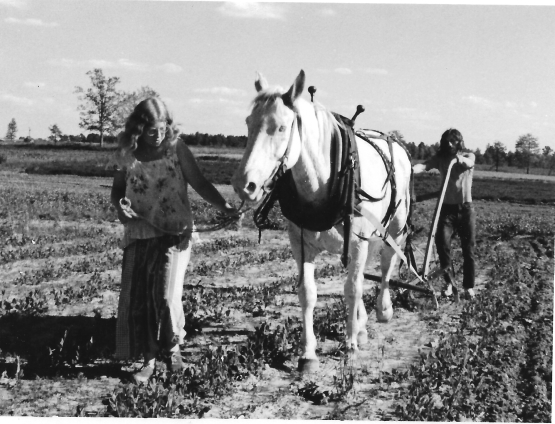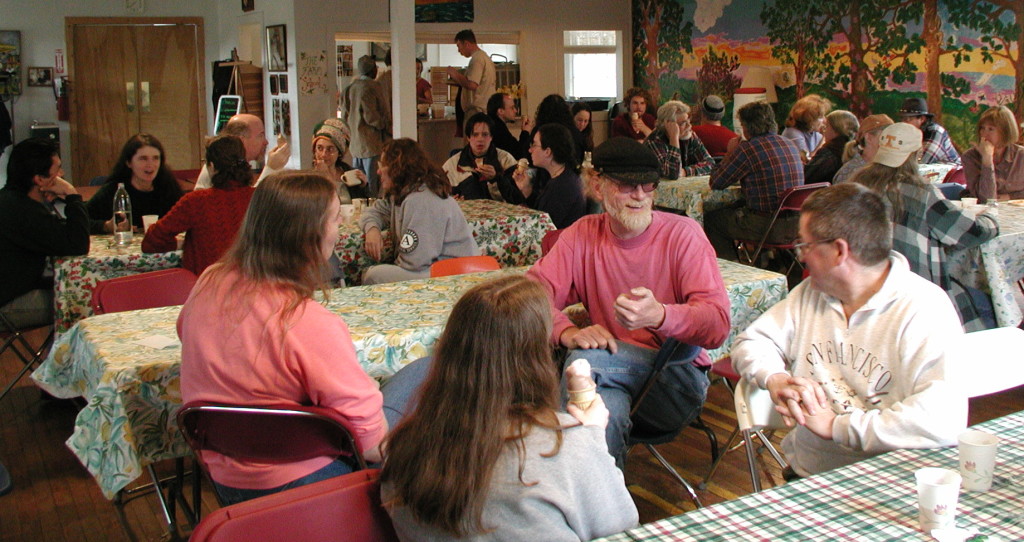An essay by Farm author and historian, Douglas Stevenson
When The Farm was founded in 1971, one of the agreements was that everyone would follow a vegan diet. The commitment to nonviolence included compassion for animals as sentient creatures. The community’s founder and spiritual teacher Stephen Gaskin expressed it this way, “I’ve been to rice boilings and I’ve been to pig stickings, and rice boiling had better vibes.”
It was also recognized that more land and resources are required to grow beans and feed them to the cows, and then eat the cows, than it does to simply get your protein directly from the beans.
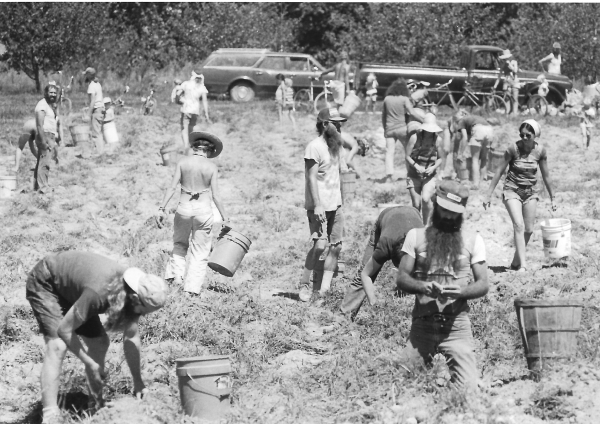 During this communal period The Farming Crew’s task was to grow all the food needed to feed community members. The community also saw the vegetarian diet as a sustainable model that could provide enough food for everyone in the world.
During this communal period The Farming Crew’s task was to grow all the food needed to feed community members. The community also saw the vegetarian diet as a sustainable model that could provide enough food for everyone in the world.
 Soybeans were identified as the only legume to contain all the amino acids for complete protein, and the highest amount of protein of any bean. Soybeans grew well in Tennessee and this became the foundation of The Farm’s vegan diet.
Soybeans were identified as the only legume to contain all the amino acids for complete protein, and the highest amount of protein of any bean. Soybeans grew well in Tennessee and this became the foundation of The Farm’s vegan diet.
A vegan diet also addresses the link between dairy and meat consumption. Cows must give birth to calves to produce milk. Boy calves become veal. Mother cows experience real loss and sorrow when their calves are taken away.
In place of cows, a soy “dairy” was assembled on The Farm that could produce milk, tofu (soy cheese), yogurt and soy ice cream or “ice bean.”
Cookbooks written by Farm members sold well and spread the acceptance of vegan and vegetarian diets across greater society. The construction of a successful soy dairy facility in Guatemala helped establish the community’s reputation, called upon to assist in the development of similar facilities for nutrition projects around the world.
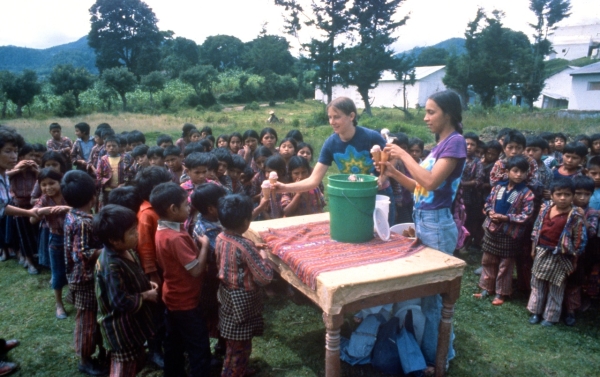 1980: Farm members/Plenty volunteer give out “ice bean” cones to school children in Guatemala.
1980: Farm members/Plenty volunteer give out “ice bean” cones to school children in Guatemala.
Things went in a new direction with the great Changeover of 1983. Agreements which had solidified into rules, setting the standards for things like appearance and diet, were relaxed, and individuals were free to decide for themselves rather than follow a community-wide mandate. Those who had difficulty digesting soy were able to acquire their protein from other sources, including dairy and meat. However most residents remained vegan or vegetarian, and it was decided as a community that no animals would be raised on the land and killed for consumption.
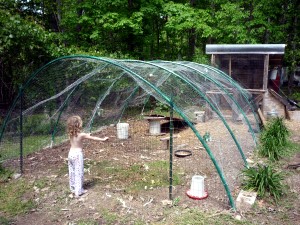 The most notable change in this regard has been the introduction and acceptance of chickens for the production of eggs. Eggs are essentially the menstrual cycle of birds and eggs will not develop into baby chickens unless the hen has been fertilized by a rooster. This makes it possible for members to raise chickens for eggs without conflicting with any community agreements. Many feel eggs are a good source of protein and chickens fit well into the sustainable lifestyle, something that is being accepted across the greater culture, even in urban environments.
The most notable change in this regard has been the introduction and acceptance of chickens for the production of eggs. Eggs are essentially the menstrual cycle of birds and eggs will not develop into baby chickens unless the hen has been fertilized by a rooster. This makes it possible for members to raise chickens for eggs without conflicting with any community agreements. Many feel eggs are a good source of protein and chickens fit well into the sustainable lifestyle, something that is being accepted across the greater culture, even in urban environments.
Over the ensuing decades since The Changeover, The Farm’s population has become more diverse, attracting new people seeking community, but who were not vegetarian. Many young people born on The Farm who left to explore the wider world often began eating meat as part of their merging with the wider culture, bringing this shift back with them upon returning to the community to settle down.
Diets are also influenced by the availability of new information as well as changes in popularity or fads, which individuals follow for one reason or another. From junk food to health food, omnivore to plant-based, gluten-free to Paleo, Farm members run the gamut of food choices.
Those seeking more community in their life but who wish to include animal husbandry in their quest for sustainability often purchase land in the nearby vicinity. They are able to develop friendships and participate in community activities while pursuing a different path.
Generally speaking, food served at community wide potlucks are expected to be vegetarian and labeled if a dish is not vegan. Gatherings at private homes or invitation-only events are free to serve whatever the hosts and their guests wish.
Ultimately the primary lesson is there is no single diet that is right for everyone. By allowing individuals to decide what diet works best for them, Farm members experience greater freedom and the community becomes more open.
I think it is important for all of us to remember that what a person eats does not define their spirituality.
It is what’s in their heart.
Douglas Stevenson
Author of Out to Change the World and The Farm Then and Now




